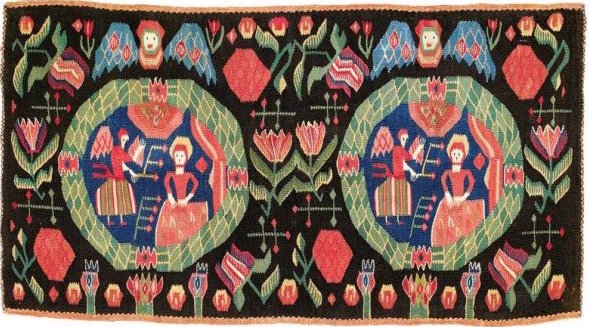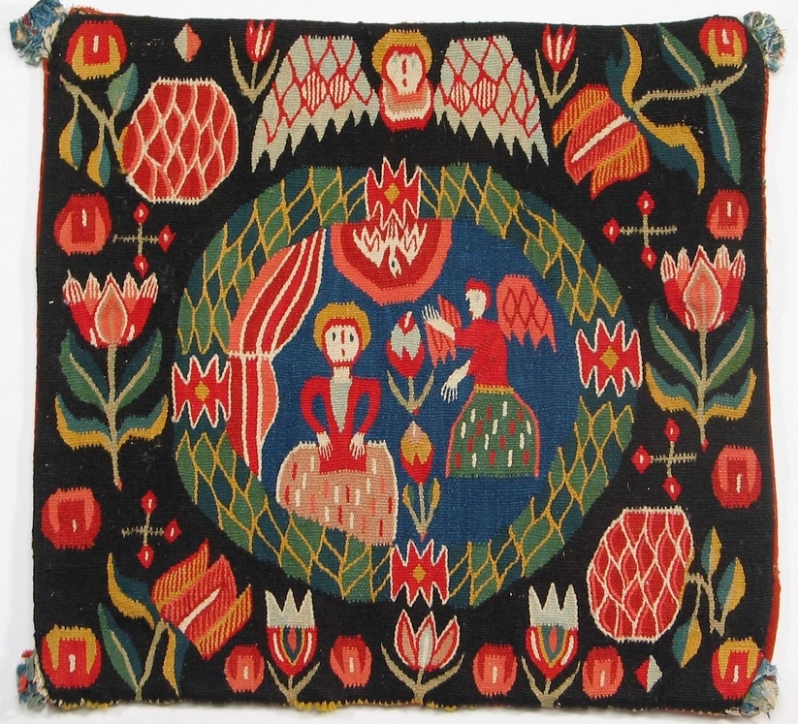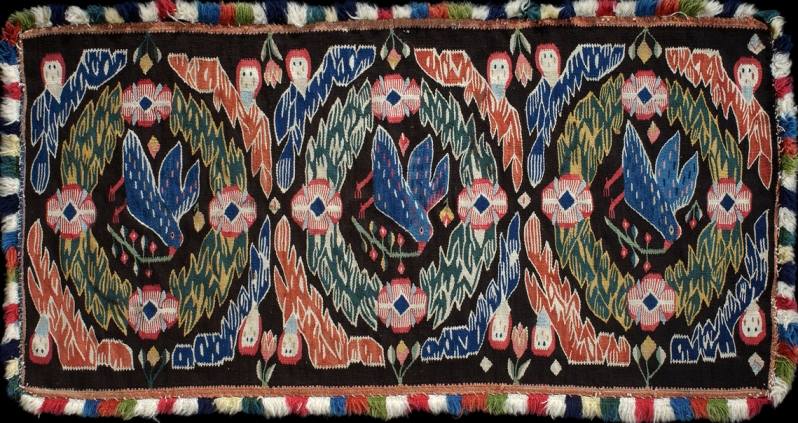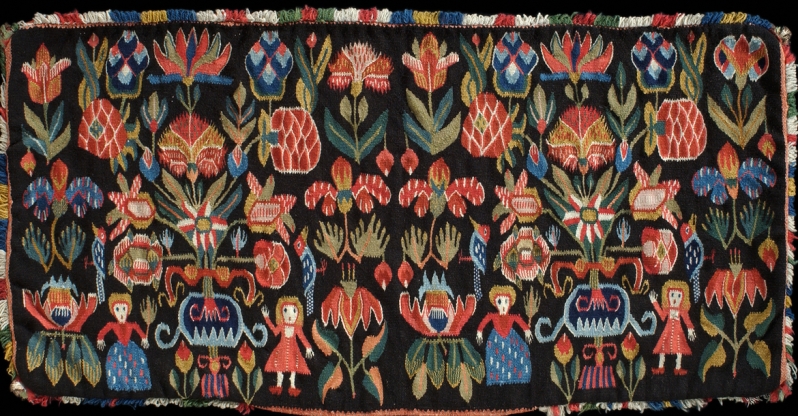With this project, my main interest is in mid-century design. But as I’ve gotten to see more and more Swedish textile work, I’ve begun to realize how rich and broad the Swedish weaving traditions are in different areas.
In Skåne, the southernmost Swedish county, the background runs even deeper. This area, for a long time part of Denmark, has a tradition of immigrant Flemish weavers, who brought their tapestry weaving skills and practiced them here. After the southern provinces of Skåne, Halland, Blekinge and Bohus were claimed by Sweden by treaty in 1658, these areas became a bit of a cultural backwater. But as styles in furniture changed, the kinds of seat covers did too. Flemish weavers, who had originally woven chair and bench covers for the merchant classes found themselves marginalized by the new fashions for leather, silk and velvet. As a result, these weavers became itinerant, carrying traditional weaving patterns with them into the local countryside, especially around Malmo and Lund. These were copied by successive generations of peasant women. From the late 18th century, and even well into the 19th century, there was a rich practice in Skåne of smaller flat-woven textiles with very lively floral and often biblical imagery. These were largely chair or bench cushions or carriage cushions used for ceremonial occasions. What these lack in terms of the perspectival refinement or shading that would have been found in professionally-woven gobelin tapestries, they make up for with vigorous color and a charming stylization of stock images.
Flamskväv is essentially a Skånian adaption of the gobelin tapestry techniques brought from Flanders. It is woven on an upright loom with the weaver sitting on a stool, and is constructed sideways, so that the narrower dimension of the piece fills the loom. This means that the warp runs from side to side on the finished piece.
It’s interesting to know about these pieces and their imagery as background to some of the weaving I’ll look at in later posts—especially the work by those who designed 20th century Swedish tapestries. The mostly-biblical imagery I am looking at here reflects in part my own interest in these, and in part the availability of allowed-to-be-used images. There are other commonly used images in the Skånian repertoire: a parrot, red bulls, a betrothed couple, the occasional castle. As with the images shown here, the level of highly detailed weaving is a constant.
In 1996, Viveka Hansen who had made a comprehensive and scholarly study of many such early weavings, published a book looking at a particularly fine collection of these, titled Swedish Textile Art: Traditional Marriage Weavings from Scania,, the Kahalili Collection. The images from her book are under copyright, so I am using images largely from the Nordiska Museet. But her book is well worth looking at to see the vivid colors, patterns, and exquisite weaving of this collection, as well as Hansen’s detailed analysis.
Anyway, here are some wonderful examples of earlier Scånian weaving:

This is an Annunciation scene, made as a carriage cushion cover (in Swedish,”åkdyna”) with duplicate images of the angel Gabriel appearing to a large-skirted Virgin Mary with halo. The dove, or Holy Ghost, hovers above on a pink ground. Gabriel offers Mary a flowering branch, probably to represent Jesus, a flower on the branch of Jesse. To the right a curtain has been drawn back on the scene. The angels above, flowers, and green wreaths around the scene portrayed are all typical and stylized elements, but colorful and fresh.

This cushion shows another Annunciation with similar elements: Mary, Gabriel, dove, blue background, wreath, curtain, overhead angel and flowers symmetrically arranged. These scenes were one of the most popular sets of imagery in Skane. The museum caption notes that the apron Mary is wearing is typical for women in a (18th-19th c.) peasant society. The tassels on the cushion, and fringe on the others were designed to prevent wear on the cushions’ corners and edges.

This åkdyna, or carriage cushion, has three birds surrounded by double circles of wreathes and angel wings. At first these appear to be birds cheerfully pulling worms, but given that the birds occupy the space inside these iconic wreaths, one wonders if these are not instead meant to represent in a more realistic fashion the dove or Holy Ghost, again carrying a flowering branch.

This bench or carriage cushion shows another typical Scånian pattern type: a male figure, wearing an 18th c coat, shoes, stockings long hair, and a female figure, again in a full skirt, with an overwhelming vase of flowers. Is this the Garden of Eden? I don’t know enough about this iconography to say. Willborg simply notes that the “urns and pairs” imagery is another of the most enduring patterns. Doubling the pattern on the two parts of the seat, is also typical and practical, since this made it possible for the cushion cover to be cut down and used later for individual chair cushions.
The vibrant imagery of these early Swedish flamskväv pieces all represent the vitality of the natural world. Yet they are also constant reminders of the religious stories which informed the spiritual life of the users of these items. As this flasmk tradition was adapted by weavers in the 20th century, there were a surprising number of direct copies of these kinds of pieces. But by mid-twentieth century tapestry designers, the religious component was largely abandoned, to be replaced with imagery which had its own story telling and offered a kind of celebratory secularism. I’ll look in future at some of the mid-century tapestries which draw on this weaving tradition from Sweden’s southern Skåne region.
Sources:
Bukowskis Auction house, Stockholm
Hansen, Viveka, Swedish Textile Art: Traditional Marriage Weavings from Scania, the Kahalili Collection , London 1996
Added April 1, 2016: Hansen, Viveka, ‘Historical Reproductions – ’18th & 19th Century Dove-tail Tapestry (G 6)’, TEXTILIS (May 22, 2015); http://textilis.net/ (Accessed: 1/4/16)
Ingers, Gertrude and Ernst Fisher, Flemish Weaving, Van Nostrand Reinhold, New York, 1971.
Nordiska Museet via digitaltmuseum.com
Nylen, Anna-Maja, Swedish Handcraft, Van Nostrand Reinhold, 1977.
Olsson, Annhelen, “Fated lives with a Skåne weaving legacy, Väv magazine, English edition, issue 2/13 p.19-21.
Willborg, Peter, Flat Weaves from Fjord and Forest, David Black Oriental Carpets, 1984.